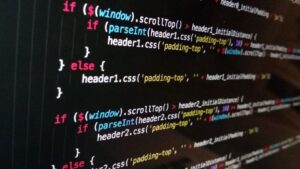In the sprawling world of technology, the term programming icon” carries a significant weight. It’s a symbol that embodies the essence of coding, a beacon guiding novices and experts alike in the digital landscape. This article delves into the intriguing realm of programming icons, shedding light on their importance and impact.
From software development to web design, programming icons are ubiquitous. They’re not just mere symbols; they’re the visual language of the tech world. So, let’s embark on this journey to better understand these vital elements of our digital lives.
Programming Icon
Programming icons play a noteworthy role in comprehension and accessibility within the technological world. They empower users by simplifying complex coding processes into identifiable images.
Comprehension and Accessibility
Programming icons act as visual aids, increasing comprehension for tech enthusiasts, novice coders, and experts alike. An icon, representing a function or a feature,  facilitates understanding of complex code. For instance, Github, a notable platform for coders, utilizes an ‘Octocat’ icon. This icon relates to its function assisting users in managing and storing revisions of projects.
facilitates understanding of complex code. For instance, Github, a notable platform for coders, utilizes an ‘Octocat’ icon. This icon relates to its function assisting users in managing and storing revisions of projects.
Furthermore, programming icons level the field for beginners. They provide a visual introduction to coding concepts with deceiving simplicity. Take the ‘play’ icon in Python’s IDLE or Visual Studio Code. It signifies running the script, sparing new coders from time-consuming, meticulous line-by-line manual execution.
Moreover, programming icons offer wholly accessible design experiences. Whether for website builders or software creators, these icons present design components ready to embed. One common illustration includes the ‘hamburger’ menu icon used widely across web pages and mobile applications for navigation purposes.
In essence, programming icons become critical tools for comprehension and accessibility in technology, painting a lucid picture of complex coding constructs.
Best Practices in Programming Icon Design
Crafting effective programming icons requires adherence to key best practices. This conversation unravels these principles, providing a comprehensive blueprint for exemplary icon creation.
Clarity and Simplicity
Elegance in icon design flows from simplicity and clarity. Keeping icons simple eliminates potential confusion. For instance, the universally recognized ‘save’ symbol, a floppy diskette, demonstrates this commitment to simplicity. Its depiction communicates action, evoking a sense of saving data. Through its clear design, it fosters ease of understanding in diverse user demographics.
Clarity also forms a crucial cornerstone in programming icon design. Icons devoid of intuitive recognition lose their communicative intent. One can look towards the ‘home’ icon as an example. It’s universally recognized, providing clear navigational guidance across platforms. The symbol – a simplified, small house – makes the icon’s function evident, leading users back to the start page.
Consistency Across Platforms
Maintaining icon consistency across platforms optimizes user experiences. It guarantees user familiarity, reducing confusion when jumping between interfaces. Take, for example, the ‘search’ icon commonly depicted as a magnifying glass. It remains a widespread symbol on various platforms, such as Google, Microsoft, and Apple. Its consistent depiction fosters an instinctive user understanding, sparking instant recognition of its function.
Incorporating User Feedback
User feedback proves instrumental in improving programming icon design. It reveals user preferences, experiences, and issues, providing invaluable insights. Customizing design based on user feedback enhances user-friendly interfaces. Social media platforms often employ this strategy. For instance, Facebook often makes design updates based on user feedback, such as adjusting the friend request icon design to improve its understandability. By integrating user feedback into the design process, programmers can enhance the effectiveness of their icons, increasing interface accessibility and user engagement.
design based on user feedback enhances user-friendly interfaces. Social media platforms often employ this strategy. For instance, Facebook often makes design updates based on user feedback, such as adjusting the friend request icon design to improve its understandability. By integrating user feedback into the design process, programmers can enhance the effectiveness of their icons, increasing interface accessibility and user engagement.
Top Tools for Creating and Editing Programming Icons
It’s clear that programming icon plays a pivotal role in enhancing user accessibility and simplifying coding processes. They’re not just pretty pictures – they’re crucial design elements that make coding more approachable and tasks more streamlined. Icons like the ‘Octocat’, ‘play’ symbol, ‘hamburger’ menu, ‘save’ symbol, and ‘home’ icon are prime examples of effective icon design. They embody the principles of clarity, simplicity, and intuitive recognition, proving that less can indeed be more. Consistency across platforms and user feedback integration are also key to creating user-friendly interfaces. So, if you’re looking to design or edit a programming icon, remember these best practices and make sure your icons are clear, simple, consistent, and user-friendly. The right icon can make all the difference in a user’s experience.
